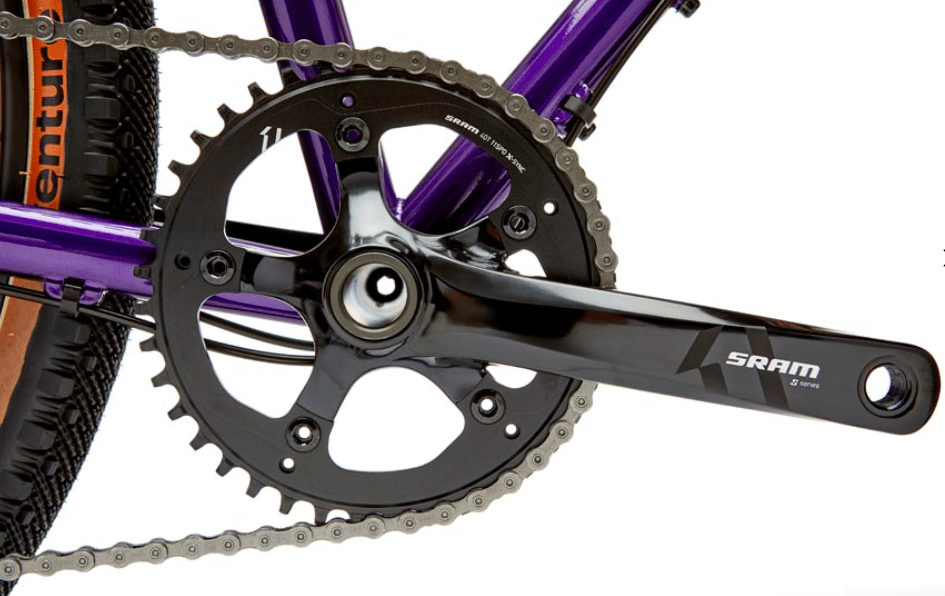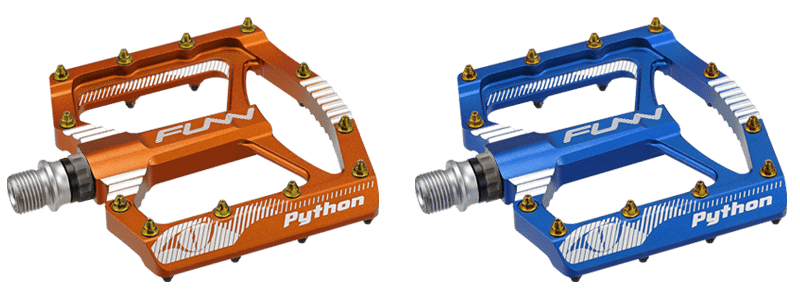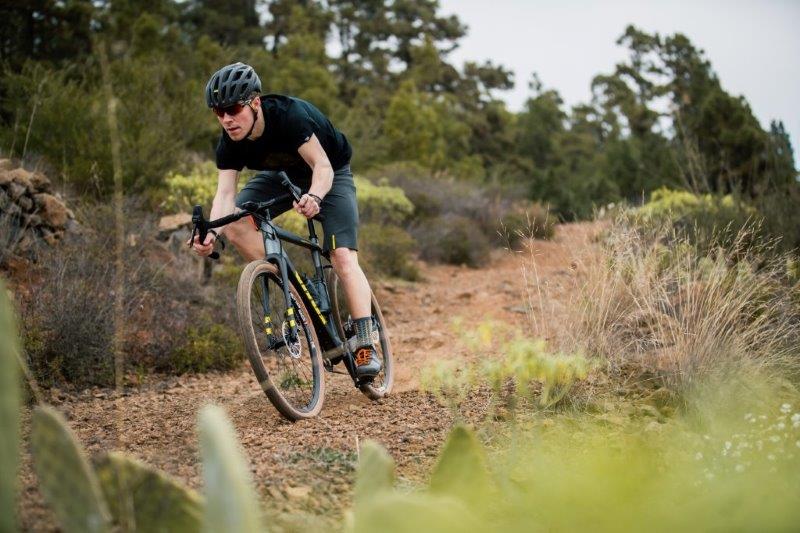Let me start of by saying that weather or not you should convert your current bike to a gravel grinder is dependant on a few things. For me it made sense to give it a try with my Surly Long Haul Trucker touring bike. As I got more and more interested in off-road bikepacking, the appeal to convert my current bike into a gravel grinder just made sense. In this article I am going to break down all the different aspects that you will have to consider if this is something that you would want to continue to go through with.
What type of bike are you looking to convert into a gravel bike? Some road bikes have restriction making them pretty much impossible to convert to a gravel bike. Like my Giant Defy is only has enough clearance for road tyre so that was a no go for a gravel grinder. The nice thing about Surly is that they make their bikes with the option to change out for fatter tires which is great. The recommended clearance for the LHT is 45 mm and that is exactly the size tires I got. But depending if you have a road bike or a touring bike. The main thing to consider is geometry and how the bike is going to feel on the rough stuff. Gravel bikes have a certain geometry design that makes them much nicer to ride compared to some other bikes.
As I mention in the article gravel bike vs road bike, there is a fine line between a gravel bike/cyclocross and adventure bikes. All are designed to be ridden off-road. But you could say adventure bikes offer more usability when it comes to carting gear with more eyelets and mounting options. That is essentially what I had planned for my Surly LHT was to turn it into a adventure bike. But it is safe to say that you could count it as a gravel bike to.
What is a gravel bike? Well they are generally bikes that one would say is a mix between a road bike and a mountain bike. Essentially a road bike that is able to ride off-road or gravel. Pedigree gravel bikes are designed for gravel grinder racing which is a US thing. But most other budget gravel bikes and other non-pedigree gravel bikes are great for taking on bikepacking adventures and could be classified as a adventure bike. As gravel bikes are often used as a bike for adventure and are sometimes referred to as adventure road bikes.
They generally have a slightly longer chainstay and wheelbase then a road bike. This extended length of the gravel bike is what makes riding, especially when under a load much more comfortable to ride then a road bike. Which brings me to what you plan to use your converted bike for? If you are converting a road bike to a gravel grinder with hopes to use it as a adventure bike or bikepacking bike. You might want to really think about it before you start converting. Only because road bike frame geometry is not the best for off-road riding when they bike is heavier because of bike bags and your camping gear. You might be better off buying a gravel bike. If you want some budget friendly option I suggest checking out these blog posts about the best gravel bikes under $500, $1000, $1500, and $2000.
If you are wanting to convert your road touring bike (something like my Surly LHT) to a gravel grinder or adventure bike, then lets take more of a look at what that entails. Now if you have a nice new and flashy touring bike. It might not be a good idea to completely re-built it into something completely different. You could make some slight changes to the bike to make it more suited to such off-road riding. But if you situation is like what mine was. Which I guess is a little more different then most. I found my Surly LHT for sale at a used bike store for a couple hundred dollars. They only good thing about the bike was the frame. So I had a good starting point to build my own adventure bike.
But lets get more into the difference when it comes to geometry. Furthermore with a road bike and gravel bike geometry difference I suggest you go check out that blog post, it goes into detail comparing a gravel bike and road bike example and breaking down the geometry differences and what that means for the overall bike riding experience.

For the example of this article I wanted to get my Surly Long Haul Trucker stock frame geometry and compare it to a gravel grinder and see what the differences are. If we were to compare a Canyon Grail AL 7.0 (gravel bike) with the Surly LHT (Touring Bike).
One of the vast differences that you will be able to notice is that the gravel bike has a a much larger Bottom bracket Drop. On the Grail it is 28 mm lower to the ground then the Surly is. Meaning that the lower the bottom bracket drop, typically the better the handling, as the rider’s centre of gravity is lowered. Which is ideal when you are riding off-road and on rough terrain. If you are looking at converting your current bike it might be wise to look at where your bike stacks up. Keep in mind that we I looked at 10 of some of the best gravel bikes around the $2000 mark the BB Drop ranged from 75 mm to 57 mm. The 57 mm Bottom Bracket Drop being still 10mm more then my touring bikes.
Comparing my touring bike the chainstay length and wheelbase are both around 30 mm longer then its gravel counterpart. This longer length helps for clearing your feet when bike touring with panniers. But is not so much needed when it comes to a gravel grinder. The chainstay length on the gravel bikes we compared range from 440 mm to 430 mm, with a wheel base length ranging from 1053 mm to 1025 mm. These lengths are longer then a road bike which means it improves stability but not as much as you can get from a touring bike. As the chainstay is shorter then a touring bike you can expect sharper handling on a gravel bike.
It is clear to see that gravel purpose bikes are built with this exact type of riding in mind. Although you can take a touring bike and convert it which I have done and will get into more soon. I must be honest the ride feel could be better. On my Surly I have changed the components and parts that I could to make it ride more like a gravel bike. But at the end of the day the frame is not ultimately set up for this type of riding, exactly.
But don’t get me wrong if you are looking to convert your bike to a gravel grinder just to see if it is something that you would like to try out to see if it is something you enjoy then there is nothing stopping you. I love it and am now in the market for a gravel grinder or more purpose built adventure bike.
There are a few things you can do to drastically change how your current bike rides on rough terrain and to make it feel more like a gravel bike. Just upgrading to gravel specific bike parts can increase your on bike comfort while riding more adventurous routes.
Handlebars

I was going to start with tires as the most important thing to change on your bike to make the conversion to a gravel grinder. Handlebars are more important then you may think. There are gravel handlebars that are built with comfort on rough terrain in mind. Offering flared drop bar options which spread you arms wider then standard road or touring handlebars. I was surprised to noticed that my gravel bars put me in a more upright riding position, while also offering much more flexibility in the bar reducing vibrations on your wrists. Further more they give you better manoeuvrability allowing for better control when you need it to dodge big rocks and stick.
Tires

Probably almost as important is tires. offering the right amount of traction and minimising rolling resistance is key for riding gravel. It also helps to get a tire that is grippy enough to get you up very steep sections that are very loose. there are so many gravel tire options out there. but typically a gravel bike has tire from 30 mm to 42 mm or more. On my Surly I got the WTB Riddlers which are 45 mm tires that seem to do a okay job at keeping up with off-road demands. You can read the review here. There is defiantly better tires out there. But this is something else to really consider in a gravel bike conversion.
Gravel Bike Gearing

Most gravel bikes run a 1 X 11 or a 2 X 11 gearing setup. Some of the better gravel bikes use Shimano GRX, SRAM Rival 1, Shimano 105, Shimano Tiagra, Shimano Deore or SRAM Apex 1 groupsets. You want access to a very low granny gear that is going to get you up very steep sections. If you don’t want to hike a bike then it is defiantly better then walking your bike on a bikepacking adventure.
Gravel Bike Pedals

Not completely necessary but defiantly can make a different in your overall energy excursion, making the most of your pedalling to transition into the bike powering ahead. There are some great options when it comes to gravel bike pedals that I have written a whole article about. Which is a great starting point if you are interested.
But other then that if you are looking to convert your bike to a gravel grinder then these places are where you want to be looking at. keep in mind that it is not always ideal to convert a bike to a gravel bike if the geometry does not make sense to do so.

